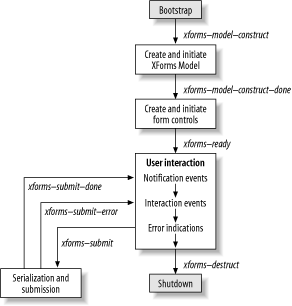XForms Events
The XML Events specification provides a clean declarative way to call out actions that should be performed under certain conditions. Under what conditions, exactly? That depends on a processing model—including the definition of what events are involved, and when they become active.
At the time of this writing, the topic of XML processing models was still under fervent discussion in various pockets of standards activity, with no obvious end in sight. Each XML specification contains details of its own self-contained processing model, but nowhere is there a description of how different specifications interact or relate to one another. XForms is no different.
An entire chapter in the XForms specification is devoted to the processing model. Much of this material, however, is mainly of interest to programmers who happen to be implementing an XForms support in some product. For form authors, a simpler view is possible.
Stages of XForms Processing
The life-cycle of an XForms processor can be divided into several categories, which is a useful viewpoint for a form author. By scrutinizing what you want to accomplish, you can narrow down the potentially huge list of events to a more manageable list. Figure 7-3 shows the stages of XForms processing.

Figure 7-3. Stages of XForms processing
- Initialization
Obviously, the first step is to initialize all the machinery underlying XForms. ...
Get XForms Essentials now with the O’Reilly learning platform.
O’Reilly members experience books, live events, courses curated by job role, and more from O’Reilly and nearly 200 top publishers.

